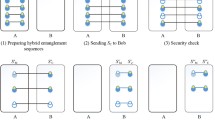Abstract
In a recent article, Gharibian (Phys Rev A 86:042106 2012) has conjectured that no two-qubit separable state of rank greater than two could be maximally non-classical (defined to be those which have normalized geometric discord 1/4) and asked for an analytic proof. In this work, we prove analytically that among the subclass of \(X\) states, there is a unique (up to local unitary equivalence) maximal separable state of rank two. For the general case, we derive some necessary conditions.
Similar content being viewed by others
References
Eisert, J., Plenio, M.: A comparison of entanglement measures. J. Mod. Opt. 46, 145–154 (1999). doi:10.1080/09500349908231260
Verstraete, F., Audenaert, K., Moor, B.D.: Maximally entangled mixed states of two qubits. Phys. Rev. A 64, 012316 (2001). doi:10.1103/PhysRevA.64.012316
Munro, W.J., James, D.F.V., White, A.G., Kwiat, P.G.: Maximizing the entanglement of two mixed qubits. Phys. Rev. A 64, 030302(R) (2001). doi:10.1103/PhysRevA.64.030302
Miranowicz, A., Grudka, A.: Ordering two-qubit states with concurrence and negativity. Phys. Rev. A 70, 032326 (2004). doi:10.1103/PhysRevA.70.032326
Ollivier, H., Zurek, W.H.: Quantum discord: a measure of the quantumness of correlations. Phys. Rev. Lett. 88, 017901 (2001). doi:10.1103/PhysRevLett.88.017901
Dakić, B., Vedral, V., Brukner, C.: Necessary and sufficient condition for nonzero quantum discord. Phys. Rev. Lett. 105, 190502 (2010). doi:10.1103/PhysRevLett.105.190502
Luo, S., Fu, S.: Geometric measure of quantum discord. Phys. Rev. A 82, 034302 (2010). doi:10.1103/PhysRevA.82.034302
Rana, S., Parashar, P.: Tight lower bound on geometric discord of bipartite states. Phys. Rev. A 85, 024102 (2012). doi:10.1103/PhysRevA.85.024102
Hassan, A.S.M., Lari, B., Joag, P.S.: Tight lower bound to the geometric measure of quantum discord. Phys. Rev. A 85, 034302 (2012). doi:10.1103/PhysRevA.85.024302
Luo, S., Fu, S.: Measurement-induced nonlocality. Phys. Rev. Lett. 106, 120401 (2011). doi:10.1103/PhysRevLett.106.120401
Datta, A.: Studies on the role of entanglement in mixed-state quantum computation. Ph.D. Thesis. arXiv:0807.4490v1
Gharibian, S., Piani, M., Adesso, G., Calsamiglia, J., Horodecki, P.: Characterizing quantumness via entanglement creation. Int. J. Quantum Inf. 9, 1701 (2011). doi:10.1142/S0219749911008258
Okrasa, M., Walczak, Z.: On two-qubit states ordering with quantum discords. EuroPhys. Lett. 98, 40003 (2012). doi:10.1209/0295-5075/98/40003
Adhikari, S., Banerjee, S.: Operational meaning of discord in terms of teleportation fidelity. Phys. Rev. A 86, 062313 (2012). doi:10.1103/PhysRevA.86.062313
Lang, M.D., Caves, C.M.: Quantum discord and the geometry of bell-diagonal states. Phys. Rev. Lett. 105, 150501 (2010). doi:10.1103/PhysRevLett.105.150501
Galve, F., Giorgi, G.L., Zambrini, R.: Maximally discordant mixed states of two qubits. Phys. Rev. A 83, 012102 (2011). doi:10.1103/PhysRevA.83.012102
Girolami, D., Adesso, G.: Interplay between computable measures of entanglement and other quantum correlations. Phys. Rev. A 84, 052110 (2011). doi:10.1103/PhysRevA.84.052110
Girolami, D., Paternostro, M., Adesso, G.: Faithful nonclassicality indicators and extremal quantum correlations in two-qubit states. J. Phys. A Math. Theor. 44, 352002 (2011). doi:10.1088/1751-8113/44/35/352002
Batle, J., Plastino, A., Plastino, A.R., Casas, M.: Peculiarities of quantum discord’s geometric measure. J. Phys. A Math. Theor. 44, 505304 (2011). doi:10.1088/1751-8113/44/50/505304
Al-Qasimi, A., James, D.F.V.: Comparison of the attempts of quantum discord and quantum entanglement to capture quantum correlations. Phys. Rev. A 83, 032101 (2011). doi:10.1103/PhysRevA.83.032101
Batle, J., Casas, M., Plastino, A.: Correlated multipartite quantum states. Phys. Rev. A 87, 032318 (2013). doi:10.1103/PhysRevA.87.032318
Chiuri, A., Vallone, G., Paternostro, M., Mataloni, P.: Extremal quantum correlations: experimental study with two-qubit states. Phys. Rev. A 84, 020304(R) (2011). doi:10.1103/PhysRevA.84.020304
Fedrizzi, A., Skerlak, B., Paterek, T., de Almeida, M.P., White, A.G.: Experimental information complementarity of two-qubit states. New J. Phys. 13, 053038 (2011). doi:10.1088/1367-2630/13/5/053038
Gharibian, S.: Quantifying nonclassicality with local unitary operations. Phys. Rev. A 86, 042106 (2012). doi:10.1103/PhysRevA.86.042106
Miranowicz, A., Horodecki, P., Chhajlany, R.W., Tuziemski, J., Sperling, J.: Analytical progress on symmetric geometric discord: measurement-based upper bounds. Phys. Rev. A 86, 042123 (2012). doi:10.1103/PhysRevA.86.042123
Dakić, B., et al.: Quantum discord as resource for remote state preparation. Nat. Phys. 8, 666–670 (2012). doi:10.1038/nphys2377
Horodecki, P., Tuziemski, J., Mazurek P., Horodecki, R.: Can communication power of separable correlations exceed that of entanglement resource? arXiv:1306.4938v2
De Vicent, J.I.: Separability criteria based on the Bloch representation of density matrices. Quantum Inf. Comput. 7, 624–638 (2007)
Horodecki, R., Horodecki, M., Horodecki, P.: Violating Bell inequality by mixed spin-\(1/2\) states: necessary and sufficient condition. Phys. Lett. A 200, 340 (1995). doi: 10.1016/0375-9601(95)00214-N
Bellomo, B., et al.: Unified view of correlations using the square-norm distance. Phys. Rev. A 85, 032104 (2012). doi:10.1103/PhysRevA.85.032104
Author information
Authors and Affiliations
Corresponding author
Appendix: Proof of the optimization in Proposition 1
Appendix: Proof of the optimization in Proposition 1
We first note that the constraint (13a) implies \(abcd\ne 0\), \(a\ne c\), \(b\ne d\). Now, let us try to parameterize \((a,b,c,d)\) using the constraints. To absorb the first constraint, without loss of generality, we can take \(a=bk,c=dk,k>0\). Then, the constraint (13b) becomes
and we are left with only the following constraint
where we have just substituted \(a\) and \(c\) in terms of \(bk\) and \(dk\), respectively, in the first equation. Squaring (19) and subtracting (20) from it yields
Noting that \(ad=bdk\), we have to find the maximum of the function
subject to \(k>0\). The derivatives are very easy to calculate. Indeed, \(f'(k)=0\) only at \(k=1\) and \(f'(1)=f''(1)=f'''(1)=0\), but \(f''''(1)=-3/16<0\). Hence, the unique maximum occurs at \(k=1\). From (19) and (21), this corresponds to the solution \(a=b=(2\pm \sqrt{2})/8,c=d=1/(32a)\).
Rights and permissions
About this article
Cite this article
Rana, S., Parashar, P. Maximally discordant separable two-qubit \(X\) states. Quantum Inf Process 13, 2815–2822 (2014). https://doi.org/10.1007/s11128-014-0865-0
Received:
Accepted:
Published:
Issue Date:
DOI: https://doi.org/10.1007/s11128-014-0865-0




